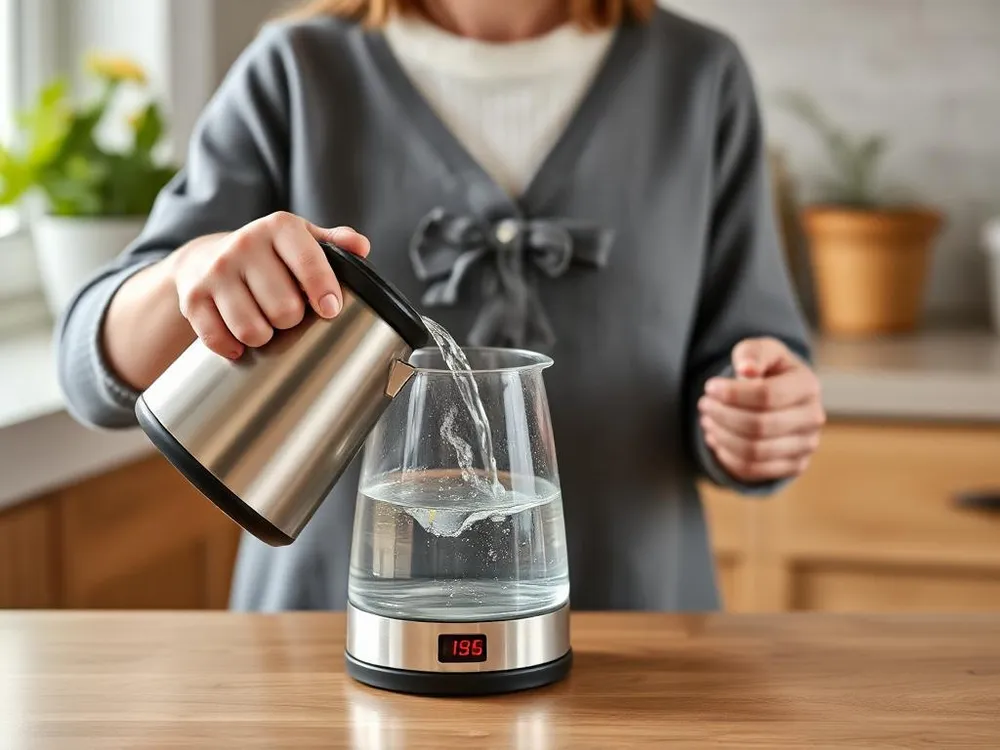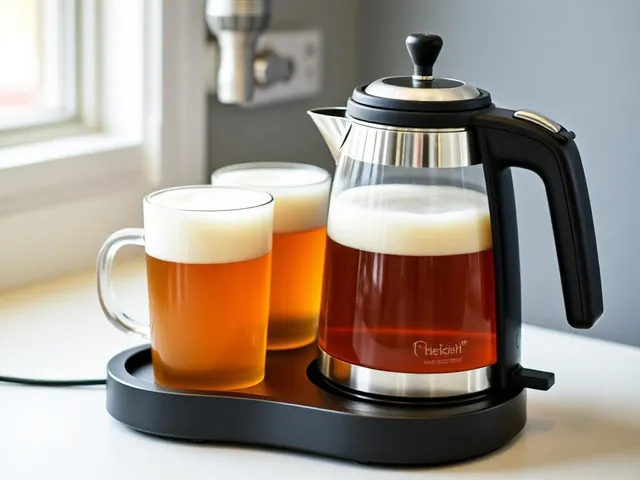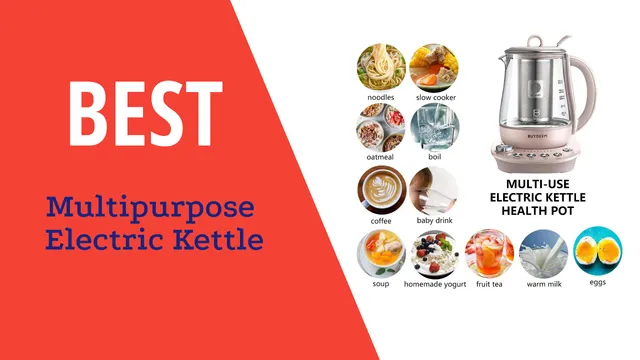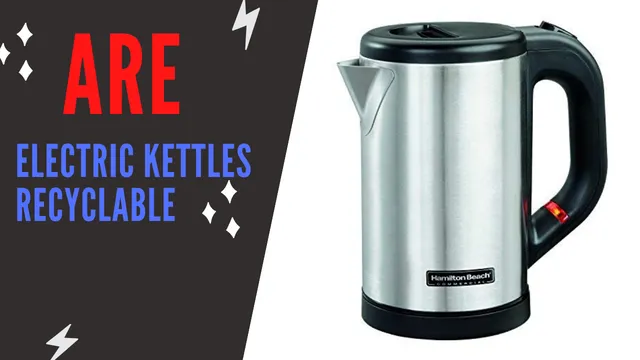The Impact of Water Quality on Electric Kettle Performance and Longevity
-
 Dragos
Dragos - October 17, 2024

Water quality plays a crucial role in the performance and lifespan of electric kettles. Whether you’re using a compact travel kettle or a large capacity model for your home, the type of water you use can significantly affect your kettle’s efficiency, the taste of your beverages, and the appliance’s durability. This comprehensive guide explores how water quality impacts electric kettles and provides tips for maintaining your kettle in top condition.
Understanding Water Quality
Before delving into its effects on electric kettles, it’s important to understand what we mean by water quality:
- Hardness: The concentration of minerals, primarily calcium and magnesium.
- pH Level: The acidity or alkalinity of water.
- Contaminants: Presence of chlorine, sediments, or other impurities.
- Total Dissolved Solids (TDS): The overall mineral content in water.
Water hardness is typically measured in parts per million (ppm) or grains per gallon (gpg). Here’s a general classification:
| Hardness Level | ppm | gpg |
|---|---|---|
| Soft | 0-60 | 0-3.5 |
| Moderately Hard | 61-120 | 3.6-7.0 |
| Hard | 121-180 | 7.1-10.5 |
| Very Hard | 180+ | 10.5+ |
For more information on how different materials in kettles interact with water, check our comparison of stainless steel vs glass vs plastic kettles.
Types of Water and Their Effects on Kettles
Different types of water can have varying impacts on your electric kettle:
-
Tap Water: Varies greatly depending on your location. It may contain minerals, chlorine, and other treatments that can affect kettle performance and taste.
-
Hard Water: High in mineral content, particularly calcium and magnesium. It’s the primary cause of limescale build-up in kettles.
-
Soft Water: Low in mineral content. While it reduces scale build-up, it can be more corrosive to certain metals.
-
Filtered Water: Removes some contaminants and can reduce hardness, potentially extending kettle life and improving taste.
-
Distilled Water: Devoid of minerals and impurities. While it prevents scale build-up, it can be more corrosive and may result in flat-tasting beverages.
-
Bottled Water: Quality varies widely. Some may be no better than tap water, while others are highly purified.
Understanding your local water type is crucial for maintaining your kettle. If you’re unsure about your water quality, consider having it tested or check your local water utility’s annual report.
How Water Quality Affects Electric Kettles
1. Scale Build-up
Hard water, rich in calcium and magnesium, leads to limescale build-up inside kettles. This can:
- Reduce heating efficiency
- Affect the taste of water and beverages
- Shorten the kettle’s lifespan
- Potentially cause overheating and safety issues
Limescale acts as an insulator, forcing the kettle to work harder to heat water. Over time, this can lead to increased energy consumption and potentially shorten the life of the heating element. In extreme cases, excessive scale build-up can even cause the kettle to overheat or malfunction.
2. Corrosion
Water with high acidity or certain mineral content can cause corrosion in metal parts of the kettle, particularly in models with exposed heating elements. This is especially problematic with soft water or distilled water, which can be more aggressive towards metals.
Corrosion can lead to:
- Metallic taste in water
- Potential leaching of metals into the water
- Weakening of kettle components over time
3. Taste and Odor
Chlorine and other contaminants in water can impart unpleasant tastes and odors, affecting the quality of your tea or coffee. This is particularly noticeable with tap water in some areas. Additionally, mineral content can alter the taste of water, which is why tea and coffee often taste different when made with water from various sources.
4. Energy Efficiency
Scale build-up acts as an insulator, requiring more energy to heat water, thus reducing the kettle’s energy efficiency. A kettle with significant scale build-up may take longer to boil water and consume more electricity in the process. For more on energy efficiency in electric kettles, read our article on are electric kettles energy efficient.
Impact on Different Kettle Types
Different kettle materials react differently to water quality issues:
| Kettle Type | Impact of Poor Water Quality |
|---|---|
| Stainless Steel | Resistant to corrosion but prone to scale build-up |
| Glass | Shows visible scale, may develop etching over time |
| Plastic | Less affected by scale, but may absorb odors |
| Copper | Highly susceptible to both scale and corrosion |
Stainless steel kettles are popular due to their durability and resistance to corrosion. However, they can still accumulate scale, which may be less visible than in glass kettles. Glass kettles allow you to see scale build-up easily, making it clear when cleaning is needed. Plastic kettles are less prone to scale build-up but may absorb odors and flavors over time.
For a deeper dive into kettle materials and their properties, check out our guide on what to check when buying an electric kettle.
Signs of Water Quality Issues in Your Kettle
Watch out for these indicators that water quality is affecting your kettle:
- Visible scale deposits: White, chalky residue inside the kettle
- Longer boiling times: Water takes longer to reach boiling point
- Strange tastes or odors in water: Metallic, chlorine, or other off-flavors
- Unusual noises during operation: Excessive noise or ‘popping’ sounds
- Discoloration of the kettle interior: Staining or etching of the surface
If you notice any of these signs, it’s time to take action to address water quality issues and maintain your kettle.
Solutions and Maintenance Tips
To mitigate the effects of poor water quality and maintain your kettle’s performance:
1. Regular Descaling
Descale your kettle regularly, especially in hard water areas. The frequency depends on your water hardness and kettle usage, but a general rule is to descale every 1-3 months. For natural descaling methods, check our guide on how to descale an electric kettle naturally.
2. Use Filtered Water
Using filtered water can significantly reduce scale build-up and improve taste. Consider installing a water filter system or using a water filter pitcher. Look for filters that reduce water hardness and remove chlorine and other contaminants.
3. Empty and Dry After Use
Don’t leave water standing in the kettle. Empty and wipe dry after each use to prevent mineral deposits and potential bacterial growth. This simple habit can significantly extend your kettle’s lifespan.
4. Regular Cleaning
Clean your kettle regularly, not just descaling. Wipe the exterior with a damp cloth and rinse the interior thoroughly. For detailed instructions, see our article on how to clean an electric kettle.
5. Consider Water Softeners
In areas with very hard water, a water softener can be a worthwhile investment for protecting all your water-using appliances, including your kettle. Water softeners work by removing calcium and magnesium ions from the water, replacing them with sodium ions.
Choosing the Right Kettle for Your Water Quality
When selecting an electric kettle, consider your local water quality:
-
Hard Water Areas:
- Choose kettles with concealed elements and easy-to-clean designs.
- Stainless steel models are often a good choice due to their durability.
- Look for kettles with built-in filters or scale collectors.
- Consider models with wide openings for easy cleaning.
-
Soft Water Areas:
- You have more flexibility, but still opt for kettles with good build quality.
- Glass kettles can be a good option as they allow you to see the water quality.
- Avoid kettles with exposed heating elements to minimize corrosion risks.
-
Areas with Taste/Odor Issues:
- Consider kettles with built-in filters or those compatible with aftermarket filters.
- Glass or high-quality stainless steel kettles are preferable to plastic, which can absorb odors.
-
Variable Water Quality:
- Look for kettles with temperature control, allowing you to adjust based on water type.
- Consider smart kettles that can remind you when to descale or clean.
For specific kettle recommendations based on water types, check our guides on best electric kettles for hard water and best electric kettles with filters.
The Role of Kettle Design in Mitigating Water Quality Issues
Modern electric kettles often incorporate features to address water quality concerns:
- Concealed Heating Elements: Reduce scale build-up and are easier to clean.
- Removable Filters: Trap scale particles and are easy to clean or replace.
- Wide Openings: Allow for easier cleaning and descaling.
- Smart Kettles: Some models have indicators to remind you when to descale.
- Temperature Control: Allows for optimal brewing temperatures, which can help with taste issues.
- Material Choices: Some kettles use special coatings or materials designed to resist scale build-up.
For examples of kettles with advanced features, check our article on best smart kettles.
Testing Water Quality
To better understand your water quality and its potential impact on your kettle:
- Home Test Kits: Available at most hardware stores, these can test for hardness, pH, and common contaminants.
- Professional Testing: Consider having your water professionally tested for a comprehensive analysis.
- Water Utility Reports: Many water utilities provide annual water quality reports to customers.
- TDS Meters: These inexpensive devices can give you a quick measure of total dissolved solids in your water.
Understanding your water quality can help you make informed decisions about kettle maintenance and whether you need additional water treatment.
Environmental Considerations
Using the right water in your kettle isn’t just about maintaining the appliance; it also has environmental implications:
- Reducing scale build-up improves energy efficiency, lowering electricity consumption.
- Using filtered tap water instead of bottled water reduces plastic waste.
- Proper maintenance extends the life of your kettle, reducing electronic waste.
- Choosing energy-efficient kettles and using them wisely can reduce your carbon footprint.
For more on environmentally friendly kettle use, see our article on are electric kettles recyclable.
Frequently Asked Questions
-
Q: Can I use distilled water in my electric kettle? A: While distilled water prevents scale build-up, it can be more corrosive to some metals. It’s generally safe for occasional use but not recommended for daily use in most kettles.
-
Q: How often should I descale my kettle? A: It depends on your water hardness and usage, but generally every 1-3 months is recommended. In very hard water areas, you might need to descale more frequently.
-
Q: Is it safe to drink water from a kettle with scale build-up? A: While not harmful in small amounts, scale can affect taste and kettle performance. It’s best to keep your kettle clean for optimal results.
-
Q: Can water quality affect the warranty of my kettle? A: Some manufacturers may void warranties if damage is caused by excessive scale build-up. Always check your warranty terms and maintain your kettle properly.
-
Q: Are there any health concerns related to water quality in kettles? A: Generally, boiling water in a kettle is safe. However, in areas with known water contamination issues, it’s best to use filtered or treated water.
Conclusion
The quality of water you use in your electric kettle significantly impacts its performance, longevity, and the taste of your beverages. By understanding these effects and taking appropriate measures, you can ensure your kettle operates efficiently, lasts longer, and consistently delivers great-tasting hot drinks.
Remember, regular maintenance, including cleaning and descaling, is key to mitigating the effects of poor water quality. Choose a kettle that suits your local water conditions, and consider water treatment options if necessary.
For more insights on getting the most out of your electric kettle, explore our other articles:
By taking care of your kettle and being mindful of water quality, you’ll enjoy better-tasting beverages and a more durable appliance for years to come.






